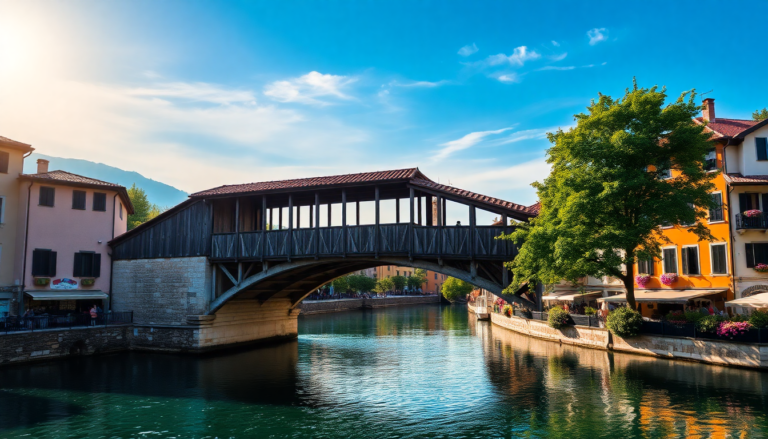Argomenti trattati
Imagine wandering through a picturesque town where each corner whispers tales of its storied past. Bassano del Grappa, nestled in the heart of Veneto, is one such place. With the Brenta River gracefully flowing through it, this charming town isn’t just a visual feast; it’s also a rich tapestry of history, culture, and culinary delights. From its iconic wooden bridge to its tantalizing local grappa, a visit to Bassano del Grappa promises an adventure that captivates the senses.
Exploring the iconic ponte degli Alpini
The well-known Ponte Vecchio, or Ponte degli Alpini, stands as a proud symbol of Bassano del Grappa. Its historical significance is palpable, as it has been rebuilt multiple times due to floods and wartime destruction. Originally crafted from wood, the bridge was designed by the brilliant architect Andrea Palladio in 1567, though his vision was initially turned down for being too reminiscent of Roman bridges. Instead, the final design maintained its traditional look but incorporated advanced structural techniques of the time.
During World War II, the bridge became a significant site of resistance. In February 1945, it was blown up by partisans to prevent enemy troops from advancing. The bridge was reconstructed after the war, thanks to the efforts of the Alpini, and reopened in 1948—a testament to the town’s resilience and spirit. Today, it serves as a crucial stop on the Valsugana cycling route, drawing visitors eager to experience its scenic beauty.
The Hemingway connection and local museums
Your journey through Bassano del Grappa wouldn’t be complete without a visit to the Museo Hemingway e della Grande Guerra. This museum pays homage to the famous author, who served as a volunteer in the Red Cross during World War I. The museum showcases five exhibition rooms filled with artifacts and documents detailing the war’s impact on the region, including pieces from Hemingway’s own collection. Personally, I found it fascinating to see how history intertwines with literature in such a profound way.
Don’t miss the Museo degli Alpini located just off the bridge. To enter, you’ll step through a quaint tavern at the bridge’s end and descend a set of stairs. Here, you can explore military memorabilia and photographs that highlight the Alpini corps’ significant role during the war. At just €1.50 per person, it’s an affordable peek into the past that’s well worth the visit.
A stroll along the Brenta and beyond
After soaking in the history, take a serene walk along the banks of the Brenta River. This picturesque path leads you to the historic “via del tabacco,” once renowned for its tobacco plantations. As you wander, be sure to stop and admire Villa Angarano Bianchi Michiel, a stunning example of Palladian architecture that is recognized as a UNESCO World Heritage Site.
At the entrance of the bridge, pop into Grapperia Nardini for a sip of classic grappa. This local establishment also offers the “tagliatella,” a unique liqueur with hints of orange blossoms, spices, and herbs, originating from the late 18th century. It’s no exaggeration to say that tasting the local spirits is a rite of passage here—just as essential as the sights themselves.
Remembering the martyrs
As you continue your exploration, make your way to Viale dei Martiri. This avenue is a solemn reminder of the 31 partisans who were executed here, with trees lining the path marked by plaques commemorating their sacrifice. It’s a poignant moment to reflect on the town’s history and the price of freedom.
Moving deeper into the historic center, you’ll arrive at Piazza Montevecchio. Here, the striking Monte di Pietà building stands out, adorned with the oldest coat of arms in the city—two rampant lions flanking a tower. Nearby, you can marvel at the Dal Corno Bonato house, featuring frescoes by Jacopo Da Ponte, known as il Bassano.
Churches and towers amidst history
The architectural richness of Bassano del Grappa doesn’t end there. The Castello degli Ezzelini and the Duomo di Santa Maria in Colle, which dates back to the 1000s, are must-see landmarks. Also, in Piazza della Libertà, you’ll find the neoclassical church of San Giovanni and the Baroque Cappella del Sacramento. These sites offer a glimpse into the town’s spiritual and architectural evolution.
One cannot overlook the Torre Civica, a towering presence in the town center dating back to the 13th century. Nearby, the Tempio Votivo dei Caduti, designed in a neo-Gothic style, serves as a memorial to the 6,000 soldiers who lost their lives during the Great War—a sobering yet essential reminder of sacrifice and valor.
Wrap up your visit with local flavors
As your day in Bassano del Grappa winds down, take a moment to savor the local cuisine. Seek out a trattoria to indulge in traditional dishes, and don’t forget to end the meal with a glass of local grappa. Whether it’s the breathtaking views from the Ponte or the rich history that envelops you, Bassano del Grappa is a place that will linger in your memory long after you leave.

